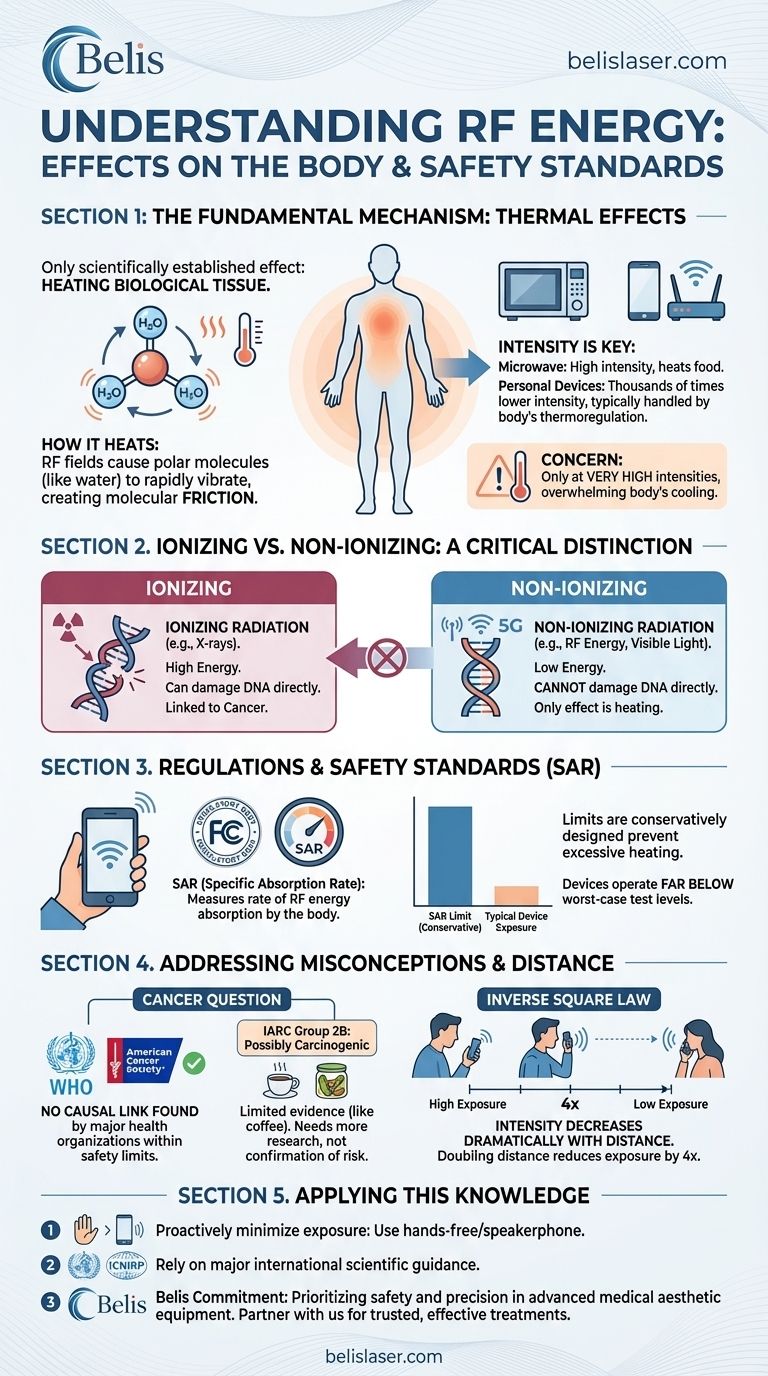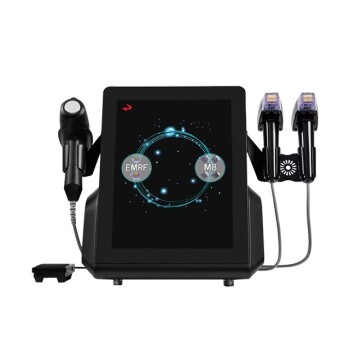At its core, the only scientifically established effect of radiofrequency (RF) energy on the human body is thermal, meaning it can heat biological tissue. This heating only occurs at very high intensities, far greater than those encountered from everyday devices like Wi-Fi routers and smartphones. The body's own thermoregulatory systems are typically sufficient to handle heat from common RF exposures.
The fundamental takeaway is that RF energy is a form of non-ionizing radiation. Unlike X-rays, it lacks the energy to damage DNA directly. Therefore, international safety standards are conservatively designed around preventing its only proven effect: excessive tissue heating.

The Fundamental Mechanism: Thermal Effects
The primary interaction between RF energy and the body is straightforward: friction at a molecular level. This is the only proven biophysical mechanism of harm.
How RF Energy Heats Tissue
RF fields cause polar molecules, especially water (which makes up about 60% of the body), to rapidly vibrate and rotate. This movement creates friction between the molecules, which in turn generates heat.
This is the exact same principle used by a microwave oven to heat food. However, the intensity of RF energy from personal devices is thousands of times lower than that of a microwave.
When Heating Becomes a Concern
This thermal effect only becomes a potential health issue when the RF intensity is high enough to overwhelm the body's ability to dissipate the extra heat. This can lead to a measurable increase in tissue and overall body temperature.
Regulatory limits are set far below the threshold where such heating could occur, providing a significant margin of safety.
Ionizing vs. Non-Ionizing: A Critical Distinction
To understand RF safety, it is essential to distinguish between two types of radiation. This is not a matter of opinion, but a fundamental principle of physics.
Ionizing Radiation (e.g., X-rays, Gamma Rays)
This is high-frequency, high-energy radiation. It carries enough energy to knock electrons out of atoms and molecules (a process called ionization), which can break chemical bonds and directly damage DNA. This DNA damage is the mechanism by which ionizing radiation can cause cancer.
Non-Ionizing Radiation (e.g., RF Energy, Visible Light)
This is low-frequency, low-energy radiation. RF energy—which includes radio waves, microwaves, Wi-Fi, and 5G signals—does not have enough energy to ionize atoms or damage DNA directly. Its only established biological effect is heating at high power levels.
Understanding the Regulations and Misconceptions
Public concern often stems from a misunderstanding of this core science. Safety regulations are built on a worst-case-scenario approach to the known thermal effects.
The Role of Safety Standards (SAR)
To regulate exposure, authorities use a metric called the Specific Absorption Rate (SAR). SAR measures the rate at which RF energy is absorbed by the body.
Regulatory bodies like the U.S. Federal Communications Commission (FCC) set strict SAR limits for all wireless devices. A device's SAR value represents the maximum possible exposure under worst-case testing conditions, not its typical operational level.
Addressing the Cancer Question
Despite decades of extensive research, major health and scientific organizations worldwide—including the World Health Organization (WHO) and the American Cancer Society (ACS)—have not found a causal link between RF exposure within safety limits and cancer.
Some confusion arises because one agency (IARC) classified RF radiation as "Group 2B: Possibly carcinogenic." This category is used for agents where evidence is limited and inconclusive, and it also includes things like coffee and pickled vegetables. It signifies a need for more research, not a confirmation of risk.
The "Inverse Square Law" in Practice
The intensity of RF energy decreases dramatically with distance from the source. Doubling your distance from a device reduces your exposure by a factor of four.
This is why exposure from a cell tower hundreds of feet away is orders of magnitude lower than the exposure from a phone held against your head, which itself is still well within safety limits.
How to Apply This Knowledge
Your approach to RF energy should be based on established science, not alarm. The existing safety framework is comprehensive and conservative.
- If your primary focus is safety with everyday devices (phones, Wi-Fi): You can be confident that devices sold to consumers operate far below the established safety limits designed to prevent any known harm.
- If you want to proactively minimize your exposure: Use hands-free options like speakerphone or earbuds for long calls, as this significantly increases the distance between the device and your head.
- If you are evaluating information about RF risks: Rely on guidance from major international scientific bodies (like WHO or ICNIRP) and national health agencies, and be critical of sources that fail to distinguish between non-ionizing and ionizing radiation.
Understanding the physics of RF energy allows you to navigate the modern wireless world with assurance rather than anxiety.
Summary Table:
| Key Concept | What It Means for You |
|---|---|
| Primary Effect | Heating of tissue at very high intensities only. |
| Radiation Type | Non-ionizing; cannot damage DNA like X-rays. |
| Safety Standard | SAR limits ensure exposure is far below harmful levels. |
| Cancer Risk | No causal link found by major health organizations. |
Ensure your clinic operates with the highest standards of safety and efficacy. BELIS specializes in professional medical aesthetic equipment that utilizes advanced energy-based technologies, including RF, with precision and safety as our core principles. If you run a medical aesthetics clinic or a premium beauty salon, partner with us to offer your clients trusted, effective treatments. Contact our experts today to learn how our equipment can enhance your service portfolio and build client trust.
Visual Guide

Related Products
- IPL SHR+Radio frecuency machine
- RF Microneedling Machine Micro Needle Radio Frequency Machine
- Ultrasonic Cavitation Radiofrecuency Machine for Body Slimming
- RF Microneedling Machine Micro Needle Radio Frequency Machine
- 4D 12D HIFU Machine Device for Skin Tightening and Lifting
People Also Ask
- What does radiofrequency do to your body? Understanding Thermal Effects for Safe Treatments
- Is it safe to use an RF machine at home? How to Use Consumer Devices Safely
- How often should I use an RF machine on my face? Optimize Your Treatment Schedule for Best Results
- How does an RF machine work? Unlock the Science of Non-Surgical Skin Tightening
- Is it safe to use RF machine everyday? Avoid These Risks for Optimal Results



















